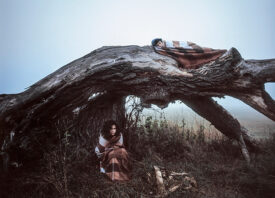Search this site
Exploring Photography in the Metaverse

I’m standing on the rooftop terrace of FRAME11 Gallery, staring at a portrait by the photographer Yanissa X. Uza’s Rainbow Eyes brings us gaze-to-gaze with Uza, her lids adorned with shimmering shades of blue, cyan, yellow, red, and purple, her hair flaming red. Below me, I have a clear view of the surrounding buildings. Verdant greenery peppers the terrace, and the sky has turned a twilight violet. On display further on this floor are works by Victoria West and Ana Isabel Hewlett; each looks so much like a painting, I have to step closer to confirm they are, in fact, photographs.

If you’ve been there yourself, you’ll know that FRAME11 Gallery exists not in a single physical space but in the metaverse. It’s part of Cryptovoxels, a virtual world powered by the Ethereum blockchain, and I’m visiting this exhibition–Persistence–from my computer at home. You don’t have to buy a ticket; you can “step” right in.
Like most artworks in a traditional gallery, Uza’s Rainbow Eyes is available to collectors, but you can’t carry the picture home with you, and you can’t ask the gallery to frame it. Instead, you can acquire it as an NFT, or non-fungible token, on the Ethereum blockchain. The same is true for every one of the photographs included in the exhibition, which runs through the end of this month.

FRAME11 was founded by the photographer Claudia Pawlak, a prominent figure in the NFT landscape. The centre is committed to exhibiting work by women and non-binary artists, in hopes of balancing the scales toward a more equal playing field. “In 2021, ArtTactic published data reporting that women account for just 16% of the NFT art market,” the artist explains. “That same study reported that male artists accounted for 77% of all primary and secondary sales in 2021.
“Within my growing photography community, I myself was witnessing many photo collections selling out in a matter of hours–mainly collections by male photographers. FRAME11 is a gallery dedicated to exhibiting the work of women and non-binary photographers, as a way to increase the visibility and sales of those artists.”

The Persistence show is ambitious and beautifully curated, spanning three floors of exhibition space. “What is exciting to me about virtual exhibitions and photography in the metaverse are installation opportunities that would not be possible in physical spaces,” Pawlak says. “In the Cryptovoxels metaverse, you can create interactable objects and gamify the exhibition experience if you so desire.”
She was inspired, in part, by another exhibition in Cryptovoxels, created by Alejandro Cartagena and Fernando Gallegos. The End of The City was the culmination of a ten-year collaboration exploring what it means to inhabit a city, even as it experiences decay in the all-consuming quest for progress and development. Enter the Cryptovoxels installation, and you’re surrounded by flying items: a chair, a tire, a sheet of plastic, and other ephemeral objects of life in an urban environment. You can reach out and grab them.
“This was the first metaverse installation that really ‘clicked’ for me and made me realize the potential of crypto-art-native exhibitions,” Pawlak tells me. “Their installation was composed of their photographs, cut and paste into 2D objects, floating around the room. The user could fly around with them, popping in and out of images, creating new narratives and discoveries as they wandered in the space. The way Cartagena and Gallegos used the metaverse to critically look at the decay of urban spaces was clever and executed in a way that benefited the NFT work.”

It’s easy to spend hours exploring Cryptovoxels. Assembly Curated is currently hosting an exhibition to coincide with the drop of Barry Stone’s /CLOUD/ series. Exploring the show is literally like walking on air. Despite the surreal and decidedly digital experience, I’m reminded of Alfred Steiglitz’s famous cloud series, Equivalents, created a century ago, the moment I enter. As it happens, Stone was inspired, in part, by Steiglitz.
Another influential gallery in the metaverse is the imnotArt gallery. Though they also have a physical gallery in Chicago, their virtual space is a joy to visit, with hardwood floors and plenty of room to explore. As of this writing, imnotArt gallery is hosting the first exhibition by the African NFT Community, Paradise, with a stellar lineup including photographic artists such as Karene-Isabelle Jean-Baptiste and ayeshachasm.eth. Previously, their exhibition BALANCE highlighted the work of women photographers, including an enchanting analog work by Angelica Ramirez and a powerful self-portrait from Taesirat Yusuf.

The street photographer Sean Bonner, himself a collector, also has a seamlessly designed and curated gallery space in Cryptovoxels, with photography by Brandon Ruffin, Julia Sky, Camila de León, and more currently on view. It comes as no surprise that Bonner came from the gallery world, having helped to build the famous SIXSPACE gallery, which opened in Chicago in 1999 with an exhibition by the American photographer Glen E. Friedman.

Despite “metaverse” being used as a singular noun, there are, in fact, multiple metaverses. Aside from Cryptovoxels, Decentraland (more specifically, the Voltaire Art District) is a popular choice among artists. It’s here, for example, that you’ll find the Sotheby’s virtual art gallery.

Like artists and curators, collectors have also begun reimagining what a “gallery space” could be and look like. For a glimpse into one potential future, we can look to Madeleine Baughn, a 3D renderer and interior designer who’s working on designing the metaverse. She’s also a collector of Wild Mustangs, the well-known NFT collection by Jessica Cardelucci, profiled here. In December of last year, after acquiring the NFT for the photograph Wind Knots, Baughn built a custom space to showcase the work.
“She created a stunning, and honestly state-of-the-art, virtual gallery,” Cardelucci tells us. “Seeing her design work in collaboration with my images is a glimpse into how beautiful the metaverse will be in the future. It was definitely a moment when I was reminded, ‘We’re still early.’”
And we are early. Although everyone seems to be talking about the metaverse, far fewer regularly visit it. Plus, the photography industry has been relatively slow to adopt NFT technology, at least in comparison to other forms of digital art. But that’s changing, and it’s changing quickly. “Time moves incredibly fast here,” Pawlak admits. “I think that as the NFT photography space moves forward, we will begin to see a merge between the traditional fine art space and the NFT space.
“Academic spaces of fine art like schools, not-for-profit organizations, museums, and other cultural institutions will look to the platforms and DAOs forming here to help their entry into the space. I think we will see physical spaces entirely dedicated to art on the blockchain with artist residencies, exhibitions, workshops, and more.
“Crypto-native artists and builders will sit on the boards of the largest cultural institutions. In three years’ time, I would dare to even predict that major museums will create wallets entirely dedicated to collecting historical art on the blockchain.” Ultimately, she leaves us with one final question: “Will those museums be traditional, or will they be created in response to crypto-art?”



